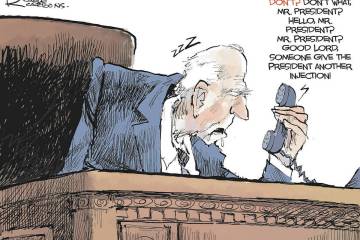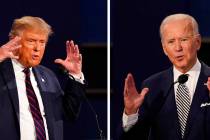Trump plays Santa with economic plan
Donald Trump has been credited with many political innovations. But his greatest contribution to politics is not his insult comedy, or even his intuition for what makes good TV.
It's that he's found a way to be both Santa Clauses.
The Two Santa Claus Theory was coined by Republican strategist Jude Wanniski in 1976. He argued that if Democrats were going to offer generous spending programs — that is, anoint themselves the "Santa Claus" of spending — Republicans needed to proffer their own gifts as well. Republican insistence on deficit-conscious spending reductions certainly seemed Scrooge-like, after all, and was turning off voters. Wanniski proposed that the GOP boost its popularity by becoming the "Santa Claus of Tax Reduction."
Trump, who will be in Las Vegas for a public rally at noon Thursday at Treasure Island's Mystere Theatre, has taken the Two Santa Claus Theory a step further. For a man who so unabashedly celebrates his own greed, he is proving himself quite generous to the general public (with other people's money, of course). Rather than choosing between spending and tax cuts, he's giving voters pretty much everything they want, price tags and deficits be damned.
Take the tax plan he announced last week. It's gonna be the greatest, most un-loser-like tax giveaway, ever. Especially if you're rich.
Trump's giant tax cuts look a lot like Jeb Bush's previously announced, wealthy-tilted plan, except with even lower rates. Trump promises to reduce personal income tax rates across the board, cutting the top marginal rate to just 25 percent, from the current 39.6 percent. Trump would cut the top capital gains rate to 20 percent, from today's 23.8 percent.
He would also reduce corporate taxes to 15 percent from their top current statutory rate of 35 percent and eliminate the estate tax.
Trump's oft-repeated (but false) claim that he'd raise taxes on the wealthy seems based solely on his willingness to close the carried interest loophole. This currently allows private equity and hedge fund partners to pay taxes on a huge chunk of their income at lower capital gains rates, even though the earnings in question aren't really capital gains. It's an indefensible loophole that should have been ended ages ago. But it also affects relatively few people, and lowering wage-and-salary tax rates as much as Trump wants to would still create a net tax cut for the uber-rich, including probably most hedge-funders.
Estimates on the budgetary impacts of Bush's (large but again still more modest) tax cuts suggest that Trump's plan would also dramatically increase government deficits, despite the candidate's declarations of revenue neutrality.
His attempt at offsetting the revenue shortfall comes primarily in the form of a gimmicky change to the treatment of taxation of overseas profits and vague language about reducing or eliminating "loopholes for the very rich and special interests." But this should offer little comfort to fiscal conservatives, at least if they believe in the laws of arithmetic.
Very wealthy households typically deduct only about 15 percent of their adjusted gross incomes. Even completely zeroing out their deductions — which, to be clear, is not what Trump proposes, since he wants to keep the costly mortgage interest and charitable deductions intact — wouldn't make up for the revenue losses from a 14.6-point top tax rate reduction.
On to his Spending Santa bona fides.
Though offering few details, Trump has broadly promised the moon, stars, perhaps even additional galaxies to greedy voters. He has vowed not to touch Social Security or Medicare, and has guaranteed more infrastructure spending, including but not limited to his "beautiful" wall on the Mexican border.
While denigrating Obamacare's largesse, he has also promised more generous health care, among other goodies.
"I am going to take care of everybody," he said on "60 Minutes," explaining that "people are going to be able to go out and negotiate great plans with lots of different competition with lots of competitors with great companies, and they can have their doctors, they can have plans, they can have everything."
So how does Trump reconcile his giveaways on both sides of the fiscal ledger with his party's alleged commitment to fiscal conservatism? Trump just promises he'll get us a really good deal — typically by getting someone else to pay for it. Maybe it's Mexico, maybe China; either way, someone else. How he'll strong-arm these sovereign nations into paying our bills, he doesn't quite bother explaining.
But no matter. Merry Christmas, everyone!
— Catherine Rampell (crampell@washpost.com) is a Washington Post columnist. Follow her on Twitter: @crampell.




























